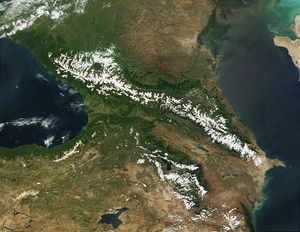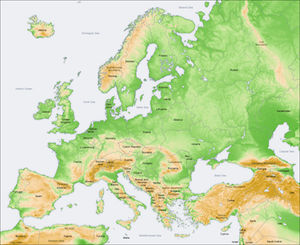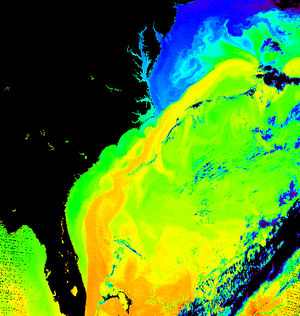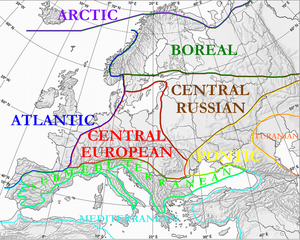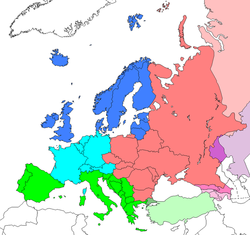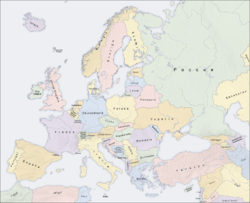Difference between revisions of "Europe"
m (→See also) |
m |
||
| (One intermediate revision by the same user not shown) | |||
| Line 1: | Line 1: | ||
| − | + | {{X}} | |
[[Image:LocationEurope.png|thumb|250px|right|World map showing Europe]] | [[Image:LocationEurope.png|thumb|250px|right|World map showing Europe]] | ||
[[Image:Europe countries map en.png|thumb|250px|right|Political map (neighbouring countries in Asia and Africa also shown)]] | [[Image:Europe countries map en.png|thumb|250px|right|Political map (neighbouring countries in Asia and Africa also shown)]] | ||
| + | |||
'''Europe''' is one of the seven traditional [[continent]]s of the [[Earth]]. The term ''continent'' here refers to a [[human geography|cultural and political]] distinction rather than a [[physical geography|physiographic]] one, leading to various perspectives about Europe's precise borders. Physically and [[geology|geologically]], Europe is the westernmost [[peninsula]] of [[Eurasia]], west of [[Asia]]. Europe is bounded to the north by the [[Arctic Ocean]], to the west by the [[Atlantic Ocean]], to the south by the [[Mediterranean Sea]], and to the southeast by the waterways adjoining the Mediterranean to and including the [[Black Sea]] and the [[Caucasus Mountains]] (in [[Caucasus (geographic region)|Caucasia]]). On the east, Europe is divided from Asia by the [[water divide]] of the [[Ural Mountains]] and by the [[Caspian Sea]]. | '''Europe''' is one of the seven traditional [[continent]]s of the [[Earth]]. The term ''continent'' here refers to a [[human geography|cultural and political]] distinction rather than a [[physical geography|physiographic]] one, leading to various perspectives about Europe's precise borders. Physically and [[geology|geologically]], Europe is the westernmost [[peninsula]] of [[Eurasia]], west of [[Asia]]. Europe is bounded to the north by the [[Arctic Ocean]], to the west by the [[Atlantic Ocean]], to the south by the [[Mediterranean Sea]], and to the southeast by the waterways adjoining the Mediterranean to and including the [[Black Sea]] and the [[Caucasus Mountains]] (in [[Caucasus (geographic region)|Caucasia]]). On the east, Europe is divided from Asia by the [[water divide]] of the [[Ural Mountains]] and by the [[Caspian Sea]]. | ||
Latest revision as of 16:33, 7 August 2009
Europe is one of the seven traditional continents of the Earth. The term continent here refers to a cultural and political distinction rather than a physiographic one, leading to various perspectives about Europe's precise borders. Physically and geologically, Europe is the westernmost peninsula of Eurasia, west of Asia. Europe is bounded to the north by the Arctic Ocean, to the west by the Atlantic Ocean, to the south by the Mediterranean Sea, and to the southeast by the waterways adjoining the Mediterranean to and including the Black Sea and the Caucasus Mountains (in Caucasia). On the east, Europe is divided from Asia by the water divide of the Ural Mountains and by the Caspian Sea.
Europe is the world's second-smallest continent in terms of area, covering about 10 400 000 square kilometres (4,010,000 sq mi) or 2.0% of the Earth's surface. The only continent smaller than Europe is Australia. In terms of population, it is the third-largest continent (after Asia and Africa) with a population of some 710,000,000, or about 11% of the world's population.
The European Union – comprising 25 member states, with two countries acceding in 2007 (Bulgaria and Romania) and two candidates in accession negotiations (Turkey and Croatia) – is the largest political and economic entity covering the European continent, while Russia (excluding portions in Asia) is the second largest entity and Europe's largest state in area and population.
Etymology
In Greek mythology, Europa was a Phoenician princess who was abducted by Zeus in bull form and taken to the island of Crete, where she gave birth to Minos. For Homer, Europe (Greek: Template:Polytonic Eurṓpē; see also List of traditional Greek place names) was a mythological queen of Crete, not a geographical designation. Later Europa stood for mainland Greece, and by 500 BC its meaning had been extended to lands to the north.
The Greek term Europe is derived from Greek words meaning broad (eurys) and face (ops) – broad having been an epithet of Earth herself in the reconstructed Proto-Indo-European religion; see Prithvi (Plataia). A minority, however, suggest this Greek popular etymology is really based on a Semitic word such as the Akkadian erebu meaning "sunset" (see also Erebus). From the Middle Eastern vantagepoint, the sun does set over Europe, the lands to the west. Likewise, Asia is sometimes thought to have derived from a Semitic word such as the Akkadian asu, meaning "sunrise", and is the land to the east from a Middle Eastern perspective.
History
The origins of Western democratic and individualistic culture are often attributed to Ancient Greece, though numerous other distinct influences, in particular Christianity, can also be credited with the spread of concepts such as egalitarianism and universality of law.
After the decline of the Roman Empire, Europe entered a long period of changes arising from what is known as the Age of Migrations. That period has been known as the "Dark Ages" to Renaissance thinkers. Isolated monastic communities in Ireland and elsewhere carefully safeguarded and compiled written knowledge accumulated previously.
During this time, the western part of the Roman Empire was "reborn" as the Holy Roman Empire, later called Holy Roman Empire of the German Nation. The eastern part of the Roman Empire became known in the west as the Byzantine Empire the 'Byzantines' themselves still called themselves Template:Polytonic Basileia tōn Romaiōn - the Empire of the Romans. In 1453, when the Ottoman Empire conquered the Byzantine capital Constantinople, the Byzantine Empire ceased to exist, with a small hold out state of Trebizond which lasted until 1461.
The Renaissance and the New Monarchs marked the start of a period of discovery, exploration, and increase in scientific knowledge. In the 15th century, Portugal opened the age of discoveries, soon followed by Spain. They were later joined by France, the Netherlands and the United Kingdom in building large colonial empires with vast holdings in Africa, the Americas, and Asia.
After the age of discovery, the ideas of democracy took hold in Europe. Struggles for independence arose, most notably in France during the period known as the French Revolution. This led to vast upheaval in Europe as these revolutionary ideas propagated across the continent. The rise of democracy led to increased tension within Europe on top of the tension already existing due to competition within the New World. The most famous of these conflicts happened when Napoleon Bonaparte rose to power and set out on a conquest, forming a new French Empire, which soon collapsed. After these conquests Europe stabilised, but the old foundations were already beginning to crumble.
The Industrial Revolution started in Great Britain in the late 18th century, leading to a move away from agriculture, much greater general prosperity and a corresponding increase in population. Many of the states in Europe took their present form in the aftermath of World War I. From the end of World War II through the end of the Cold War, Europe was divided into two major political and economic blocks: Communist nations in Eastern Europe and Capitalist countries in Southern Europe, Northern Europe and Western Europe. About 1990, with the fall of the Berlin Wall, the wider Iron Curtain, and the Soviet Union the Eastern Block disintegrated.
European integration has been a theme in European relations since the end of the second World War and has spread to Eastern Europe since the end of the Cold War. The European Union, the successor to the European Community, has enlarged from 6 original founding members to 25 today, and on 27th September 2006, the countries of Bulgaria and Romania were formally approved the right of sucession, to happen early in 2007. The issue of Turkey is still a contentious one, being a transcontinental country and predominantly Muslim, the negotiations can last for 15 years. The European Union has developed from a peace-keeping and economic orientated organisation into an entity resembling a confederation. NATO has also enlarged since the end of the Cold War, with a number of Eastern European countries joining.
Geography and extent
Physiographically, Europe is the northwestern constituent of the larger landmass known as Eurasia, or Afro-Eurasia: Asia occupies the eastern bulk of this continuous landmass and all share a common continental shelf. Europe's eastern frontier is now commonly delineated by the Ural Mountains in Russia. The first century AD geographer Strabo, took the Tanais River to be the boundary, as did early Judaic sources. The southeast boundary with Asia is not universally defined. Most commonly the Ural or, alternatively, the Emba River serve as possible boundaries. The boundary continues to the Caspian Sea, the crest of the Caucasus Mountains or, alternatively, the Kura River in the Caucasus, and on to the Black Sea; the Bosporus, the Sea of Marmara, the Dardanelles, and the Aegean Sea conclude the Asian boundary. The Mediterranean Sea to the south separates Europe from Africa. The western boundary is the Atlantic Ocean; Iceland, though nearer to Greenland (North America) than mainland Europe, is generally included in Europe.
Because of sociopolitical and cultural differences, there are various descriptions of Europe's boundary; in some sources, some territories are not included in Europe, while other sources include them. For instance, geographers from Russia and other post-Soviet states generally include the Urals in Europe while including Caucasia in Asia. Similarly, numerous geographers consider Azerbaijan's and Armenia's southern borders with Iran and Turkey's southern and eastern borders with Syria, Iraq and Iran as the boundary between Asia and Europe because of political and cultural reasons.Template:Fact In the same way, despite being close to Asia and Africa, the Mediterranean islands of Cyprus and Malta are considered part of Europe and currently form part of the EU.
Physical geography
Land relief in Europe shows great variation within relatively small areas. The southern regions, however, are more mountainous, while moving north the terrain descends from the high Alps, Pyrenees and Carpathians, through hilly uplands, into broad, low northern plains, which are vast in the east. This extended lowland is known as the Great European Plain, and at its heart lies the North German Plain. An arc of uplands also exists along the north-western seaboard, which begins in the western parts of the islands of Britain and Ireland, and then continues along the mountainous, fjord-cut, spine of Norway.
This description is simplified. Sub-regions such as the Iberian Peninsula and the Italian Peninsula contain their own complex features, as does mainland Central Europe itself, where the relief contains many plateaus, river valleys and basins that complicate the general trend. Sub-regions like Iceland, Britain and Ireland are special cases. The former is a land unto itself in the northern ocean which is counted as part of Europe, while the latter are upland areas that were once joined to the mainland until rising sea levels cut them off.
Climate

Europe lies mainly in the temperate climate zones, being subjected to prevailing westerlies.
The climate is milder in comparison to other areas of the same latitude around the globe due to the influence of the Gulf Stream. The Gulf Stream is nicknamed "Europe's central heating", because it makes Europe's climate warmer and wetter than it would otherwise be. The Gulf Stream not only carries warm water to Europe's coast but also warms up the prevailing westerly winds that blow across the continent from the Atlantic Ocean.
Therefore the average temperature throughout the year of Naples is 16 °C (60.8 °F), while it is only 12 °C (53.6 °F) in New York City which is almost on the same latitude. Berlin, Germany; Calgary, Canada; and Irkutsk, in the Asian part of Russia, lie on around the same latitude; January temperatures in Berlin average around 8 °C (15 °F) higher than those in Calgary, and they are almost 22 °C (40 °F) higher than average temperatures in Irkutsk.
Geology
Template:Main The Geology of Europe is hugely varied and complex, and gives rise to the wide variety of landscapes found across the continent, from the Scottish Highlands to the rolling plains of Hungary.
Europe's most significant feature is the dichotomy between highland and mountainous Southern Europe and a vast, partially underwater, northern plain ranging from England in the west to Ural Mountains in the east. These two halves are separated by the mountain chains of the Pyrenees and Alps/Carpathians. The northern plains are delimited in the west by the Scandinavian Mountains and the mountainous parts of the British Isles. Major shallow water bodies submerging parts of the northern plains are the Celtic Sea, the North Sea, the Baltic Sea complex and Barents Sea.
The northern plain contains the old geological continent of Baltica, and so may be regarded geologically as the "main continent", while peripheral highlands and mountainous regions in the south and west constitute fragments from various other geological continents. Most of the older geology of Western Europe existed as part of the ancient microcontinent Avalonia.
Geological history
The geological history of Europe traces back to the formation of the Baltic Shield (Fennoscandia) and the Sarmatian craton, both around 2.25 billion years ago, followed by the Volgo-Uralia shield, the three together leading to the East European craton (≈ Baltica) which became a part of the supercontinent Columbia. Around 1.1 billion years ago, Baltica and Arctica (as part of the Laurentia block) became joined to Rodinia, later resplitting around 550 million years ago to reform as Baltica. Around 440 million years ago Euramerica was formed from Baltica and Laurentia; a further joining with Gondwana then leading to the formation of Pangea. Around 190 million years ago, Gondwana and Laurasia split apart due to the widening of the Atlantic Ocean. Finally, and very soon afterwards, Laurasia itself split up again, into Laurentia (North America) and the Eurasian continent. The land connection between the two persisted for a considerable time, via Greenland, leading to interchange of animal species. From around 50 million years ago, rising and falling sea levels have determined the actual shape of Europe, and its connections with continents such as Asia. Europe's present shape dates to the late Tertiary period about five million years ago.
Biodiversity
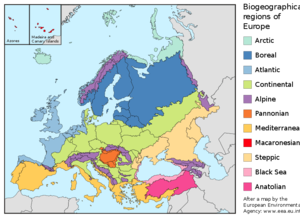
Having lived side-by-side with agricultural peoples for millennia, Europe's animals and plants have been profoundly affected by the presence and activities of man. With the exception of Fennoscandia and northern Russia, few areas of untouched wilderness are currently found in Europe, except for various national parks.
The main natural vegetation cover in Europe is mixed forest. The conditions for growth are very favourable. In the north, the Gulf Stream and North Atlantic Drift warm the continent. Southern Europe could be described as having a warm, but mild climate. There are frequent summer droughts in this region. Mountain ridges also affect the conditions. Some of these (Alps, Pyrenees) are oriented east-west and allow the wind to carry large masses of water from the ocean in the interior. Others are oriented south-north (Scandinavian Mountains, Dinarides, Carpathians, Apennines) and because the rain falls primarily on the side of mountains that is oriented towards sea, forests grow well on this side, while on the other side, the conditions are much less favourable. Few corners of mainland Europe have not been grazed by livestock at some point in time, and the cutting down of the pre-agricultural forest habitat caused disruption to the original plant and animal ecosystems.
Probably eighty to ninety per cent of Europe was once covered by forest. It stretched from the Mediterranean Sea to the Arctic Ocean. Though over half of Europe's original forests disappeared through the centuries of deforestation, Europe still has over one quarter of its land area as forest, such as the taiga of Scandinavia and Russia, mixed rainforests of the Caucasus and the Cork oak forests in the western Mediterranean. During recent times, deforestation has been slowed and many trees have been planted. However, in many cases monoculture plantations of conifers have replaced the original mixed natural forest, because these grow quicker. The plantations now cover vast areas of land, but offer poorer habitats for many European forest dwelling species which require a mixture of tree species and diverse forest structure. The amount of natural forest in Western Europe is just 2–3% or less, in European Russia 5–10%. The country with the smallest percentage of forested area (excluding the micronations) is Iceland (1%), while the most forested country is Finland (77%).
In temperate Europe, mixed forest with both broadleaf and coniferous trees dominate. The most important species in central and western Europe are beech and oak. In the north, the taiga is a mixed spruce-pine-birch forest; further north within Russia and extreme northern Scandinavia, the taiga gives way to tundra as the Arctic is approached. In the Mediterranean, many olive trees have been planted, which are very well adapted to its arid climate; Mediterranean Cypress is also widely planted in southern Europe. The semi-arid Mediterranean region hosts much scrub forest. A narrow east-west tongue of Eurasian grassland (the steppe) extends eastwards from Ukraine and southern Russia and ends in Hungary and traverses into taiga to the north.
Glaciation during the most recent ice age and the presence of man affected the distribution of European fauna. As for the animals, in many parts of Europe most large animals and top predator species have been hunted to extinction. The woolly mammoth was extinct before the end of the Neolithic period. Today wolves (carnivores) and bears (omnivores) are endangered. Once they were found in most parts of Europe. However, deforestation and hunting caused these animals to withdraw further and further. By the Middle Ages the bears' habitats were limited to more or less inaccessible mountains with sufficient forest cover. Today, the brown bear lives primarily in the Balkan peninsula, Scandinavia, and Russia; a small number also persist in other countries across Europe (Austria, Pyrenees etc.), but in these areas brown bear populations are fragmented and marginalised because of the destruction of their habitat. In addition, polar bears may be found on Svalbard, a Norwegian archipelago far north of Scandinavia. The wolf, the second largest predator in Europe after the brown bear, can be found primarily in Eastern Europe and in the Balkans, with a handful of packs in pockets of Western Europe (Scandinavia, Spain, etc.).
Other important European carnivores are Eurasian lynx, European wild cat, foxes (especially the red fox), jackal and different species of martens, hedgehogs, different species of reptiles (like snakes as (vipers and grass snakes) and amphibians, different birds (owls, hawks and other birds of prey).
Important European herbivores are snails, larvae, fish, different birds, and mammals, like rodents, deer and roe deer, boars, and living in the mountains, marmots, steinbocks, chamois among others.
Sea creatures are also an important part of European flora and fauna. The sea flora is mainly phytoplankton. Important animals that live in European seas are zooplankton, molluscs, echinoderms, different crustaceans, squids and octopuses, fish, dolphins, and whales.
Biodiversity is protected in Europe through the Council of Europe's Bern Convention, which has also been signed by the European Community as well as non-European states.
Demographics
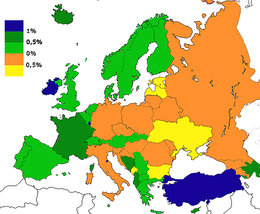
Since the Renaissance, Europe has had a major influence in culture, economics and social movements in the world. The most significant inventions had their origins in the Western world, primarily Europe and the United States. European demographics are important not only historically, but also in understanding current international relations and population issues.
Some current and past issues in European demographics have included religious emigration, race relations, economic immigration, a declining birth rate and an aging population. In some countries, such as Ireland and Poland, access to abortion is currently limited; in the past, such restrictions and also restrictions on artificial birth control were commonplace throughout Europe. Abortion remains illegal on the island of Malta where Catholicism is the state religion. Furthermore, three European countries (The Netherlands, Belgium and Switzerland) and the Autonomous Community of Andalusia (Spain) have allowed a limited form of voluntary euthanasia for some terminally ill people.
In 2005 the population of Europe was estimated to be 731 million according to the United Nations, which is slightly more than one-ninth of the world's population. A century ago Europe had nearly a quarter of the world's population. The population of Europe has grown in the past century, but in other areas of the world (in particular Africa and Asia) the population has grown far more quickly. According to UN population projection, Europe's population may fall to about 7% of world population by 2050, or 653 million people (medium variant, 556 to 777 million in low and high variants, respectively). Within this context, significant disparities exist between regions in relation to fertility rates. The average number of children per female of child bearing age is 1.52. According to some sources, this rate is higher among Muslims. In 2005 the EU had an overall net gain from immigration of 1.8 million people, despite having one of the highest population densities in the world. This accounted for almost 85% of Europe's total population growth. A tough new EU immigration law detaining illegal immigrants for up to 18 months before deportation has triggered outrage across Latin America, with Venezuelan President Hugo Chávez threatening to cut off oil exports to Europe.
Europe is home to the highest number of migrants of all global regions at 70.6 million people, the IOM's report said. The centres are part of an EU effort to control a big surge in illegal immigration to Europe while meeting a need for low-skilled labour.
Political geography
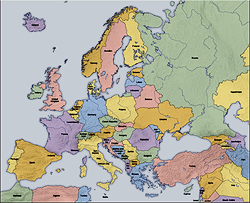
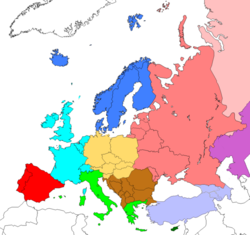

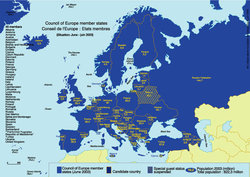
According to different definitions, the territories may be subject to various categorisations. The table below shows the scheme for geographic subregions used by the United Nations, alongside the regional grouping published in the CIA factbook. The socio-geographical data included are per sources in cross-referenced articles. Where they differ, provisos are clearly indicated.
The 27 European Union member states are highly integrated economically and politically; the European Union itself forms part of the political geography of Europe.
In 2008, the Freedom House classified the following countries of Europe as not free: Azerbaijan, Belarus, Kazakhstan, Kosovo, and Russia.
| Name of regiona[›] and territory, with flag |
Area (km²) |
Population (1 July 2002 est.) |
Population density (per km²) |
Capital |
|---|---|---|---|---|
| Template:FlagiconÅland Åland (Finland) | 1,552 | 26,008 | 16.8 | Mariehamn |
| 28,748 | 3,600,523 | 125.2 | Tirana | |
| 468 | 68,403 | 146.2 | Andorra la Vella | |
| 29,800 | 3,229,900 | 101 | Yerevan | |
| 83,858 | 8,169,929 | 97.4 | Vienna | |
| 86,600 | 8,621,000 | 97 | Baku | |
| 207,600 | 10,335,382 | 49.8 | Minsk | |
| 30,510 | 10,274,595 | 336.8 | Brussels | |
| 51,129 | 4,448,500 | 77.5 | Sarajevo | |
| 110,910 | 7,621,337 | 68.7 | Sofia | |
| 56,542 | 4,437,460 | 77.7 | Zagreb | |
| 9,251 | 788,457 | 85 | Nicosia | |
| 78,866 | 10,256,760 | 130.1 | Prague | |
| 43,094 | 5,368,854 | 124.6 | Copenhagen | |
| 45,226 | 1,415,681 | 31.3 | Tallinn | |
| 1,399 | 46,011 | 32.9 | Tórshavn | |
| 336,593 | 5,157,537 | 15.3 | Helsinki | |
| 547,030 | 59,765,983 | 109.3 | Paris | |
| 69,700 | 4,661,473 | 64 | Tbilisi | |
| 357,021 | 83,251,851 | 233.2 | Berlin | |
| 5.9 | 27,714 | 4,697.3 | Gibraltar | |
| 131,940 | 10,645,343 | 80.7 | Athens | |
| 78 | 64,587 | 828.0 | St. Peter Port | |
| 93,030 | 10,075,034 | 108.3 | Budapest | |
| 103,000 | 307,261 | 2.7 | Reykjavík | |
| 70,280 | 4,234,925 | 60.3 | Dublin | |
| 572 | 73,873 | 129.1 | Douglas | |
| 301,230 | 58,751,711 | 191.6 | Rome | |
| 116 | 89,775 | 773.9 | Saint Helier | |
| 2,724,900 | 15,217,711 | 5.6 | Astana | |
| 10,887 | 2,126,708 | 220 | Pristina | |
| 64,589 | 2,366,515 | 36.6 | Riga | |
| 160 | 32,842 | 205.3 | Vaduz | |
| 65,200 | 3,601,138 | 55.2 | Vilnius | |
| 2,586 | 448,569 | 173.5 | Luxembourg | |
| 25,333 | 2,054,800 | 81.1 | Skopje | |
| 316 | 397,499 | 1,257.9 | Valletta | |
| 33,843 | 4,434,547 | 131.0 | Chişinău | |
| 1.95 | 31,987 | 16,403.6 | Monaco | |
| 13,812 | 616,258 | 44.6 | Podgorica | |
| 41,526 | 16,318,199 | 393.0 | Amsterdam | |
| 324,220 | 4,525,116 | 14.0 | Oslo | |
| 312,685 | 38,625,478 | 123.5 | Warsaw | |
| 91,568 | 10,409,995 | 110.1 | Lisbon | |
| 238,391 | 21,698,181 | 91.0 | Bucharest | |
| 17,075,400 | 142,200,000 | 26.8 | Moscow | |
| 61 | 27,730 | 454.6 | San Marino | |
| 88,361 | 9,663,742 | 109.4 | Belgrade | |
| 48,845 | 5,422,366 | 111.0 | Bratislava | |
| 20,273 | 1,932,917 | 95.3 | Ljubljana | |
| 504,851 | 45,061,274 | 89.3 | Madrid | |
Mayen Islands (Norway) |
62,049 | 2,868 | 0.046 | Longyearbyen |
| 449,964 | 9,090,113 | 19.7 | Stockholm | |
| 41,290 | 7,507,000 | 176.8 | Bern | |
| 783,562 | 70,586,256 | 93 | Ankara | |
| 603,700 | 48,396,470 | 80.2 | Kiev | |
| 244,820 | 61,100,835 | 244.2 | London | |
| 0.44 | 900 | 2,045.5 | Vatican City | |
| Total | 10,180,000o[›] | 731,000,000o[›] | 70 |
Biodiversity
Having lived side-by-side with agricultural peoples for millennia, Europe's animals and plants have been profoundly affected by the presence and activities of man. With the exception of Scandinavia and northern Russia, few areas of untouched wilderness are today to be found in Europe, except for different national parks.
The main natural vegetation cover in Europe is forest. The conditions for growth are very favourable. In the north, the Gulf Stream and North Atlantic Drift warm the continent. Southern Europe could be described as having a warm, but mild climate. There are frequent summer droughts in this region. Mountain ridges also affect the conditions. Some of these (Alps, Pyrenees) are oriented east-west and allow the wind to carry large masses of water from the ocean in the interior. Others are oriented south-north (Scandinavian Mountains, Dinarides, Carpathians, Apennines) and because the rain falls primarily on the side of mountains that is oriented towards sea, forests grow well on this side, while on the other side, the conditions are much less favourable. Few corners of mainland Europe have not been grazed by livestock at some point in time, and the cutting down of the pre-agricultural forest habitat caused disruption to the original plant and animal ecosystems.
Eighty to ninety per cent of Europe was once covered by forest. It stretched from the Mediterranean Sea to the Arctic Ocean. Though over half of Europe's original forests disappeared through the centuries of deforestation, Europe still has over one quarter of its land area as forest, such as the taiga of Scandinavia and Russia, mixed rainforests of the Caucasus and the Cork oak forests in the western Mediterranean. During recent times, deforestation has been slowed and many trees have been planted. However, in many cases monoculture plantations of conifers have replaced the original mixed natural forest, because these grow quicker. The plantations now cover vast areas of land, but offer poorer habitats for many European forest dwelling species which require a mixture of tree species and diverse forest structure. The amount of natural forest in Western Europe is just 2–3% or less, in European Russia 5–10%. The country with the smallest percentage of forested area (excluding the micronations) is the Republic of Ireland (8%), while the most forested country is Finland (72%).

In temperate Europe, mixed forest with both broadleaf and coniferous trees dominate. The most important species in central and western Europe are beech and oak. In the north, the taiga is a mixed spruce-pine-birch forest; further north within Russia and extreme northern Scandinavia, the taiga gives way to tundra as the Arctic is approached. In the Mediterranean, many olive trees have been planted, which are very well adapted to its arid climate; Mediterranean Cypress is also widely planted in southern Europe. The semi-arid Mediterranean region hosts much scrub forest. A narrow east-west tongue of Eurasian grassland (the steppe) extends eastwards from Ukraine and southern Russia and ends in Hungary and traverses into taiga to the north.
Glaciation during the most recent ice age and the presence of man affected the distribution of European fauna. As for the animals, in many parts of Europe most large animals and top predator species have been hunted to extinction. The woolly mammoth and aurochs were extinct before the end of the Neolithic period. Today wolves (carnivores) and bears (omnivores) are endangered. Once they were found in most parts of Europe. However, deforestation caused these animals to withdraw further and further. By the Middle Ages the bears' habitats were limited to more or less inaccessible mountains with sufficient forest cover. Today, the brown bear lives primarily in the Balkan peninsula, Scandinavia, and Russia; a small number also persist in other countries across Europe (Austria, Pyrenees etc.), but in these areas brown bear populations are fragmented and marginalised because of the destruction of their habitat. In addition, polar bears may be found on Svalbard, an autonomous Norwegian island region far north of Scandinavia. The wolf, the second largest predator in Europe after the brown bear, can be found primarily in Eastern Europe and in the Balkans, with a handful of packs in Spain and Scandinavia.
Other important European carnivores are Eurasian lynx, European wild cat, foxes (especially the red fox), jackal and different species of martens, hedgehogs, different species of snakes (vipers, grass snake...), different birds (owls, hawks and other birds of prey).
Important European herbivores are snails, amphibian larvae, fish, different birds, and mammals, like rodents, deer and roe deer, boars, and living in the mountains, marmots, steinbocks, chamois among others.
Sea creatures are also an important part of European flora and fauna. The sea flora is mainly phytoplankton. Important animals that live in European seas are zooplankton, molluscs, echinoderms, different crustaceans, squids and octopuses, fish, dolphins, and whales.
Demographics
Almost all of Europe was possibly settled before or during the last ice age about 10,000 years ago. It has been suggested that Neanderthal man and modern man coexisted during at least some of this time. Roman road building helped with the interbreeding of the native Europeans' genetics. In contemporary times Europe has one of the lowest fertility rates in the world.
Political geography
Extent

Languages and cultures
- See also: Eurolinguistics
There are several linguistic groups widely recognised in Europe. These sometimes (but not always) coincide with cultural and historical connections between the various nations, though in other cases religion is considered a more significant distinguishing factor.
Romance languages
Romance languages are spoken more or less in south-western Europe, as well as Romania and Moldova which are situated in Eastern Europe. This area consists of: Italy, Spain, Portugal, France, Romania, Moldova, French-speaking Belgium (Wallonia, Brussels), Romandy, French-speaking Switzerland, Romansh-speaking Switzerland, and Italian-speaking Switzerland. All Romance languages are derived from the Roman language, Latin.
Germanic languages
Germanic languages are spoken more or less in north-western Europe and some parts of central Europe. This region consists of: Norway, Sweden, Germany, most of the United Kingdom and the Republic of Ireland, Denmark, the Netherlands, Austria, Liechtenstein, most of Switzerland, Iceland, Flanders and the German-speaking areas of Belgium, the Faroe Islands, Luxembourg, the Swedish-speaking municipalities of Finland, and South Tyrol in Italy.
Slavic languages
Slavic languages are spoken in Central, Eastern, and Southeastern Europe. This area consists of: Belarus, Bosnia and Herzegovina, Bulgaria, Croatia, the Czech Republic, Saxony and Brandenburg in Germany, the Republic of Macedonia, Montenegro, Poland, Russia, Serbia, Slovakia, Slovenia and Ukraine.
Cyrillic Alphabet
The Cyrillic alphabet is named after St Cyril, a missionary from Byzantium. It was invented in the First Bulgarian Empire sometime during the 10th century AD, possibly by St Kliment of Ohrid, to write the Old Church Slavonic language. The Cyrillic alphabet achieved its current form in 1708 during the reign of Peter the Great. Four letters were eliminated from the alphabet in a 1917/18 reform.
The Cyrillic alphabet has been adapted to write over 50 different languages, mainly in Russia, Central Asia and part of Eastern Europe. In many cases additional letters are used, some of which are adaptations of standard Cyrillic letters, while others are taken from the Greek or Latin alphabets.
Uralic languages
The Uralic Languages are divided into three main groups of which the Finno-Permic languages are spoken in Finland, Estonia and European Russia while the Ugric languages are spoken in Hungary, parts of Romania, Slovakia, Serbia, Ukraine, and Siberian Russia. These two main branches form the group of the Finno-Ugric languages.
Altaic languages
Turkic Languages are spoken in Turkey, Azerbaijan, the Turkish Republic of Northern Cyprus (recognised only by Turkey), parts of Bulgaria, parts of Greece, parts of Romania, parts of the Republic of Macedonia, parts of Moldova, parts of Russia, parts of Ukraine and parts of the Caucasus.
Baltic languages
Baltic languages are spoken in Lithuania and Latvia. (Estonia's national language is part of the Finno-Ugric family even though it is a Baltic state geographically.)
Celtic languages
Celtic Languages were originally used only to describe the Gaelic language in Ireland, however the term now extends to the other Gaelic and Brythonic languages. Celtic Europe are those countries and regions where Celtic languages are spoken. The Celtic nations are: Ireland, Scotland (UK), Wales (UK), Cornwall (UK), the Isle of Man (a British Crown dependency) and Brittany (within France). These are all nations where a Celtic language is spoken and share in Celtic organisations (see Pan Celticism).
Sometimes considered Celtic nations are Galicia and Asturias (both autonomous communities of Spain), and England (in addition to Cornwall) where Celtic influence remains in some regional dialects (see Cumbric), although England's Celtic languages died out as recently as the 18th century in Devon.
Other languages
Outside of these six main linguistic groups one can find:
- The Greek language, spoken in Greece, Cyprus and parts of Turkey, Albania and Italy, and in Greek diaspora communities in several other European countries (most notably Germany).
- The Albanian language is its own independent branch of the Indo-European language family with no close living relatives. Most scholars maintain that it derives from the Illyrian language. Major Albanian-speaking communities outside Albania live in Kosovo, Macedonia, Montenegro, Greece, and Turkey.
- Ibero-Caucasian, a group that includes ethnic groups throughout the Caucasus region (both North and South). Ibero-Caucasian languages are not linked to the Indo-European languages. This group includes Georgians, Abkhaz, Chechens, Ingush, Bats, and a number of other smaller ethnic groups that reside in the Caucasus.
- The Maltese language, a member of the Afro-Asian group, which includes Arabic and Hebrew, is spoken in Malta. Unlike other Semitic languages, Maltese is written in the Roman alphabet.
- The Basque language is spoken in parts of southern France and northern Spain, i.e. the Basque Country
Religions
The most popular religions of Europe are the following:
- Christianity
- Roman Catholicism: Countries or areas with significant Catholic populations are Portugal, Spain, France, Luxembourg, Belgium, south Netherlands, the Republic of Ireland, Northern Ireland, south and west Germany, south Switzerland, Italy, Malta, Austria, Hungary,Slovenia, Croatia, the Croatian parts of Bosnia and Herzegovina, Slovakia, the Czech Republic, Poland, west Belarus,Romania, Latgale region in Latvia, and Lithuania. There are also large Catholic minorities in England, Scotland, Wales and most European Countries.
- Eastern-Rite Catholicism: including west Ukraine.
- Orthodox Christianity: The countries with significant Orthodox populations are Albania, Armenia, Belarus, Bosnia and Herzegovina, Bulgaria, Cyprus, Finland (Karelia), Georgia, Greece, the Former Yugoslav Republic of Macedonia, Moldova, Montenegro, Romania, Russia, Serbia, Ukraine.
- Protestantism: Countries with significant Protestant populations include Norway, Iceland, Sweden, Finland, Estonia, Latvia, the United Kingdom, Denmark, Germany, the Netherlands and Switzerland. There are significant minorities in France, Czech Republic, Hungary.
- Islam: Countries with significant Muslim population are Albania, Bosnia and Herzegovina, Bulgaria, Republic of Macedonia, Serbia (especially in Kosovo), Montenegro, several republics of Russia, Crimea in Ukraine, Kazakhstan, Turkey, Azerbaijan and Georgia. Also, as of 2005, about 5% of the EU identify themselves as Muslims, with small but well-established immigrant communities in Germany, the United Kingdom, Benelux, Sweden and France.
Other religions are practised by smaller groups in Europe, including:
- Judaism, mainly in Germany, France, United Kingdom, Russia and Turkey.
- Hinduism, mainly among Indian immigrants in the United Kingdom.
- Buddhism, thinly spread throughout western Europe, and in Kalmykia, Russia
- Indigenous European pagan traditions and beliefs, many countries.
- Rastafari, communities in the United Kingdom, France, Spain, Portugal, Italy and elsewhere.
- Sikhism and Jainism, both mainly among Indian immigrants in the United Kingdom.
- Voodoo, mainly among black Caribbean and West African immigrants in the United Kingdom and France.
- Traditional African Religions (including Muti), mainly in the United Kingdom and France.
Millions of Europeans profess no religion or are atheist or agnostic. The largest non-confessional populations (as a percentage) are found in the Netherlands, Sweden, the Czech Republic, Belgium and France, although most former communist countries have significant non-confessional populations. Attendance at church is a minority activity in most Western European countries - as an example, the Church of England attracts around 1 million worshippers on a Sunday [1], which corresponds to about 2% of the population of England.
Official religions
A number of countries in Europe have official religions, including Liechtenstein, Malta, Monaco, Vatican City (Catholic), Greece (Eastern Orthodox); Denmark, Iceland, and Norway (Lutheran). In Switzerland, some cantons are officially Catholic, others Reformed Protestant. Some Swiss villages even have their religion as well as the village name written on the signs at their entrances.
Georgia has no established church, but the Georgian Orthodox Church enjoys "de facto" privileged status. In Finland, both Finnish Orthodox Church and Lutheran church are official. England, a part of the UK, has Anglicanism as its official religion. Scotland, another part of the UK, has Presbyterianism as the 'National' church, but is no longer "official", and in Sweden, the 'National' church is Lutheran, but no longer "official". Portugal, Spain, France, Romania, Turkey and Azerbaijan are officially "secular".
External links
- "Europe". The Columbia Gazetteer of the World Online. 2005. New York: Columbia University Press.
- Essays on European Borders, Identity, Culture and Society Hidden Europe Magazine. pub. Berlin: Germany (in English)
- Europe at Night at NASA Earth Observatory
- Need to know about Visiting Europe
- Regions of Europe
- EUFPC European Foreign Policy Council
- Parks in Europe - National parks, nature parks, reserves and other protected areas.
- Eastern European Photos @ ee-photo.com
- 500+ Photos of Europe
- Genetic distribution for the world and specifically for Europe (PDF)
- Europe2U Maps Photos and information about Europe.
- Maps of Europe
- Panoramic photos of Central Europe
- History and institutions of the united Europe (videos, photos, maps,...) : European Navigator
- International Newspaper Political, business and economic news for EU, Balkans, Russia and Eurasia. Includes news analysis, editorial and Kassandra's Notebook. : New Europe Newspaper

